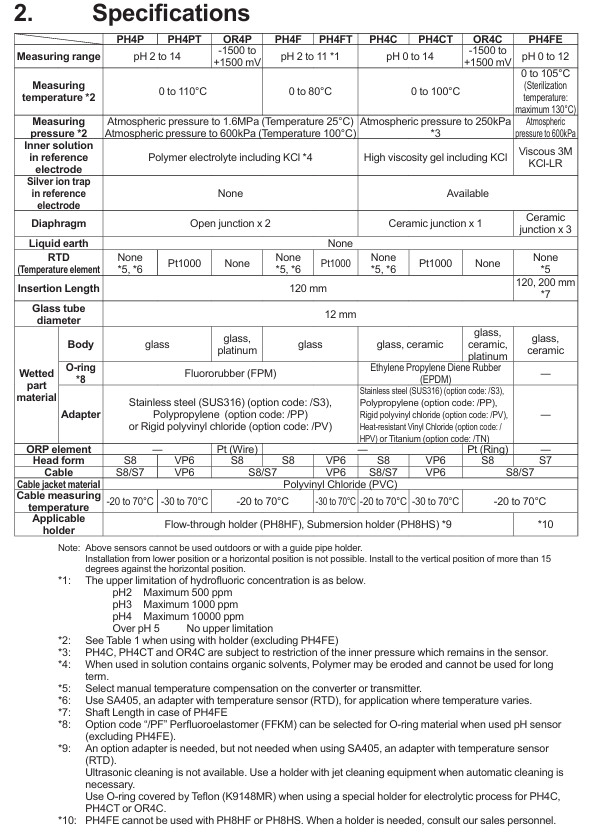How to install and wire Yokogawa PH4/OR4 series pH and ORP sensor (IM12B10B00-01EN)?
How to install and wire Yokogawa PH4/OR4 series pH and ORP sensor (IM12B10B00-01EN)?
Product positioning and core series
1. Core positioning
PH4/OR4 series is a special electrochemical sensor designed for different severe working conditions. Through differentiated materials (such as HF resistant glass, perfluoroelastomer), electrolyte type (polymer electrolyte, high viscosity gel) and structure (built-in RTD, pressurized design), the PH4/OR4 series can solve the measurement stability problem of ordinary sensors under strong corrosion, high temperature, high viscosity and other scenarios. At the same time, it is compatible with mainstream transmitters in Yokogawa to meet industrial reliability requirements.
2. Series models and applicable scenarios
The series includes 9 sub models, classified according to measurement parameters (pH/ORP) and adaptability to working conditions. The core differences are as follows:
Model Series Type Core Features Applicable Scenarios
PH4P/PH4PT polymer electrolyte pH sensor with built-in polymer electrolyte (including KCl), no risk of liquid leakage; PH4PT with Pt1000 RTD (temperature compensation); General scenarios (such as municipal sewage and neutral solutions), without the need for frequent electrolyte replenishment;
The PH4F/PH4FT anti HF corrosion pH sensor is made of anti HF glass material, which can withstand low pH (2-11) and HF concentration (≤ 500 ppm at pH 2); PH4FT with RTD; Scenarios containing hydrofluoric acid (such as semiconductor cleaning, fluorine chemical industry);
PH4C/PH4CT special chemical pH sensor has a wide pH range (0~14) and built-in pressurized gel electrolyte (initial 250 kPa) to prevent medium infiltration; PH4CT with RTD; Strong acid-base and high viscosity media (such as chemical reaction vessels and acid-base neutralization processes);
OR4P/OR4C ORP sensor OR4P (polymer electrolyte, platinum wire electrode), OR4C (pressurized gel, platinum ring electrode); OR4P: Universal oxidation-reduction scenarios (such as wastewater treatment and disinfection); OR4C: Pollution prone scenarios (such as sulfide containing solutions);
PH4FE fermentation specific pH sensor long axis design (120/200mm), open electrolyte replenishment port, suitable for deep measurement in fermentation tanks; The biological fermentation process (such as pharmaceutical and food fermentation) requires regular replenishment of electrolytes;

Detailed explanation of technical specifications
1. Basic measurement parameters
Parameter category specification details (taking typical models as examples)
PH measurement range: PH4P/PH4CT 0~14 pH, PH4F 2~11 pH;
Accuracy: Slope ≥ 96% (25 ℃), asymmetric potential ± 15 mV;
Response time: t ₉₀<15 seconds (pH 7 → 4 step);
ORP measurement range: -1500~+1500 mV;
Electrode material: OR4P (platinum wire), OR4C (platinum ring);
Reference system: Ag/AgCl (containing KCl electrolyte);
Temperature adaptation without RTD model: -20~70 ℃ (ambient), process temperature varies from 0~105 ℃ depending on the model;
Model with RTD (such as PH4PT): Built in Pt1000 (-20~200 ℃) for temperature compensation;
Pressure adapted atmospheric pressure model (PH4P/PH4F): maximum immersion depth of 3m;
Pressure model (PH4C/OR4C): Initial pressure of 250 kPa, gradually decreasing with use, to avoid process pressure exceeding the internal pressure of the sensor;
Contact material body: borosilicate glass/HF resistant glass;
Electrolyte: PH4P (polymer), PH4C (high viscosity gel) PH4FE(3M KCl-LR);
Sealing components: Fluororubber (FPM)/Perfluoroelastomer (FFKM, optional/PF);
There is no clear IP rating for protection and installation, and it is necessary to cooperate with brackets (such as PH8HS/PH8HF) to achieve waterproofing; The installation angle should be ≥ 15 ° (horizontal upward) to avoid residual bubbles; Prohibit outdoor or pipe hanging use;
2. Key operating condition limitations
Some models have strict operating conditions restrictions, and when selecting, special attention should be paid to:
PH4F/PH4FT (anti HF): The upper limit of HF concentration increases with pH (500 ppm at pH 2, 10000 ppm at pH 4), and the upper limit of temperature is 80 ℃;
PH4C/PH4CT/OR4C (pressurized): The process pressure should be ≤ the internal pressure of the sensor (initial 250 kPa), and the internal pressure can be determined by the "gas layer length" of the thin tube inside the sensor (the shorter the gas layer, the higher the internal pressure);
PH4FE (fermentation specific): Only compatible with customized brackets, prohibited from being paired with PH8HS/PH8HF universal brackets, and the electrolyte replenishment port should be regularly opened to check the liquid level;
Selection guide: Model and suffix code
1. Core selection dimensions
The selection should clarify the three dimensions of measurement parameters (pH/ORP), operating conditions (temperature/pressure/corrosiveness of the medium), and supporting equipment (transmitter/bracket). After prioritizing the matching model, the detailed configuration should be determined through suffix codes:
Example of key considerations for selection dimensions (such as chemical HF scenarios)
- EMERSON
- Honeywell
- CTI
- Rolls-Royce
- General Electric
- Woodward
- Yaskawa
- xYCOM
- Motorola
- Siemens
- Rockwell
- ABB
- B&R
- HIMA
- Construction site
- electricity
- Automobile market
- PLC
- DCS
- Motor drivers
- VSD
- Implications
- cement
- CO2
- CEM
- methane
- Artificial intelligence
- Titanic
- Solar energy
- Hydrogen fuel cell
- Hydrogen and fuel cells
- Hydrogen and oxygen fuel cells
- tyre
- Chemical fiber
- dynamo
- corpuscle
- Pulp and paper
- printing
- fossil
- FANUC
- Food and beverage
- Life science
- Sewage treatment
- Personal care
- electricity
- boats
- infrastructure
- Automobile industry
- metallurgy
- Nuclear power generation
- Geothermal power generation
- Water and wastewater
- Infrastructure construction
- Mine hazard
- steel
- papermaking
- Natural gas industry
- Infrastructure construction
- Power and energy
- Rubber and plastic
- Renewable energy
- pharmacy
- mining
- Plastic industry
- Schneider
- Kongsberg
- NI
- Wind energy
- International petroleum
- International new energy network
- gas
- WATLOW
- ProSoft
- SEW
- wind
- ADVANCED
- Reliance
- YOKOGAWA
- TRICONEX
- FOXBORO
- METSO
- MAN
- Advantest
- ADVANCED
- ALSTOM
- Control Wave
- AB
- AMAT
- STUDER
- KONGSBERG
- MOTOROLA
- DANAHER MOTION
- Bently
- Galil
- EATON
- MOLEX
- Triconex
- DEIF
- B&W
- ZYGO
- Aerotech
- DANFOSS
- KOLLMORGEN
- Beijer
- Endress+Hauser
- MOOG
- KB
- Moxa
- Rexroth


Email:wang@kongjiangauto.com






















































































































